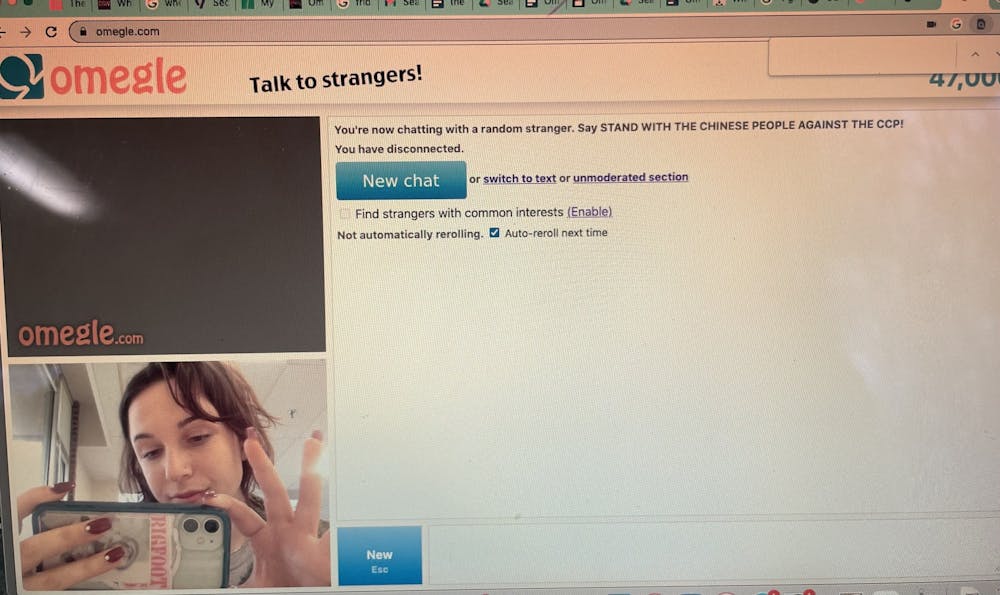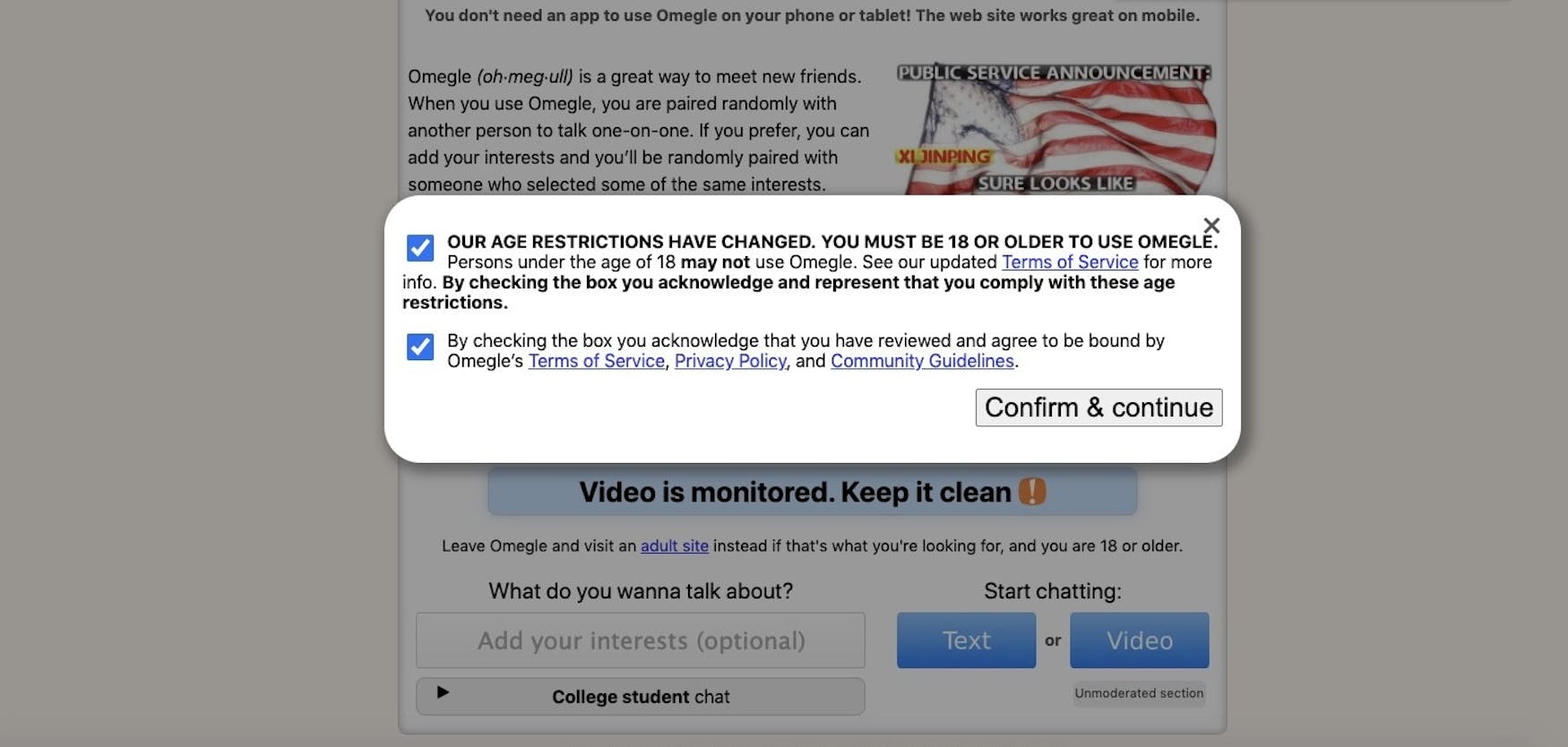The best (and worst) people on the internet still use Omegle
The online chat and video site, active since 2009, surged in popularity over the pandemic and is reportedly still peaking. What do we think about the website, and who still uses it?
Content warning: this article contains content pertaining to sexual abuse.
When I was eight or nine, I had this neighbor, G, whose house I’d run over to whenever I was bored. She was a few years older than me and I thought she was extremely cool, partly because she had this little compartment under her bed that you could crawl into, but mostly because she had unmonitored access to the Internet. In the dark, warm crawl space under her bed, G introduced me to 2010’s online north star: chat sites, but specifically Omegle. There, G became Parisian; her hidey-hole a mansion in the Alps, or she became a model, or an actress, or whatever else she wanted to be that day. Sometimes she’d turn away and hide her screen and laugh, and I would want to know what she was typing out or looking at so badly I felt nauseous.
Omegle is an online chat and video-calling site that has been active since 2009. It has both a chat feature — monitored — and a video chat feature — unmonitored — that allows users to connect with strangers across the world, either at random or by matching common interests through “tags.”
“It’s from within the era when the internet was so new,” Julia Plaisted ’23 said about online chat sites, including Omegle, in a Feb. 12 interview. “Like when there weren’t restrictions on things … like early YouTube. Crazy shit was on YouTube. I saw police reports on early YouTube.”
In recent years, Omegle has made a surprising resurgence. According to Mel Magazine, “interest in the site peaked in 2013 then dipped to its lowest in 2018. Once quarantine began in 2020, though, interest steadily grew once more. After October, Omegle saw a sharp increase in traffic, growing to nearly twice the popularity of 2013. Currently, that popularity continues.” As of now, HelpLama reports an active average of 139,880 users on Omegle every hour.

NEW CHAT: Omegle offers a chatbox to the right of its livestream.
But as book-banning increases in severity in conservative states, MySpace falls, and Tumblr flip-flops on its nudity ban, content moderation — especially when minors are perceived to be involved — is as divisive as ever. Parents tend to associate the site with online grooming; it’s faced heavy criticism for providing a platform for predators to connect with minors. For many of my peers — G included — it played a significant role in early adolescence.
The implementation of the Stop Enabling Sex Traffickers Act and the Fight Online Sex Trafficking Act in 2018 under the Trump administration, along with related legislation, played a large role in the controversy. SESTA/FOSTA led to a mass purge of sexual material and sites that platformed it across the Internet, something that sex workers and allies felt has pushed them underground and away from their own autonomy. “Internet censorship tends to be based on loose perception and opinion rather than fact. SESTA/FOSTA allows state and federal law enforcement the discretion to judge what is and isn’t ‘appropriate,’” reads a statement from the organization Decriminalize Sex Work’s website. Omegle has had lawsuits pertaining to the facilitation of child abuse in which SESTA/FOSTA has come into play, but the site has ultimately emerged unscathed.
Plaisted described how she and her friends used the site as young teenagers. “We’d pretend to be adult women,” she said. “We’d give guys fake numbers. We pretended to work at cafes, like ‘oh, I work at a cafe by Penn Station’… I thought it was a prank. We thought they were looking for other adults. We didn’t realize that they were looking for thirteen year olds.”
But not everyone remembers Omegle as being sketchy. “I remember it had always been this goofy, “if-I’m-bored-I’ll-hop-on-Omegle thing,’” Sam Richards ’24 said about his experiences as a young teenager on the site. “I think it’s an interesting concept. I thought it was sweet … talking to a complete stranger.”
With a backdrop of controversy, a newfound post-pandemic resurgence, and in the context of modern content moderation, I decided to return to Omegle to see how it played into its own lore. Who was still using it? What kinds of connections were people making with each other?
***
Aiden, a round-faced 13-year-old on a sleepover with his friends Connor and Oscar in Derry, Ireland, said in a Feb. 12 Omegle interview that they were on the site purely because they were bored. “If I told them now, they’d be pissed,” he said when I asked if his parents knew what they were up to. “But if I told them in a few years, that’d be fine.” Somewhere behind Aiden, Oscar hit a vape.
Tyler, a 16-year old from Melbourne, Australia, said that he had been using Omegle for two weeks and had frequent encounters with “dudes getting mad cuz’ I’m not a girl.” When this happened, he said “I troll them. I tell them I’m a girl first … and [then] I just scream loud.” Despite this, he said he had made a decent amount of friends from the site to play Xbox with.
Salena, a 20-year-old from New York who described using Omegle since she was fourteen, said that she also encountered harassment from men on the site. “I’m into piercings and tattoos, and I’m on those tags a lot. And once I saw a guy with his 4 or 2 gauge Prince Albert [phallic piercing] out. I immediately skipped it … but it’s Omegle. You expect to see shit like this,” she said.
Still, Salena said she appreciated the site for the love it has brought into her life. “I met one of my best friends here a year and a half ago. Me and her are like sisters now,” she said. She’d met a boyfriend on the site too, an Australian, but they broke up after a few months because of the distance. “We’re still friends. I still occasionally talk to him,” she said.
Not everyone agreed that it was possible to make meaningful connections on the site. “It’s not possible to find love on Omegle…love is a feeling, not an attraction,” said Shreyens, a computer science student in India who said he was on Omegle in an attempt to figure out how its algorithm worked. “It’s an energy and emotion. People are here [on Omegle] for attraction.” Shreyens later told me he was also on the site in an attempt to “find out abusers,” though he did not elaborate on what that meant or if he had had any success.
Juan Felipe, a young adult from Colombia, took a minute to think before talking about his experiences with connecting with strangers through Omegle. “It’s weird finding love by [way of] a screen,” he finally wrote in the Omegle chat. “But maybe I can find curious people, and in that way, yeah, also love.”
***
Ultimately, I was surprised by the few-dozen people I talked to – many were eager and open, all hailing from different parts of the world. Nobody seemed to be pretending to be different; several people acknowledged that they often used Omegle because they were lonely and didn’t have anyone to talk to in their day-to-day lives. The younger teenagers I spoke with seemed incredibly jaded but also at peace with their choices. “I saw people flash, but not very often in the last few hours. Only once,” Aiden said cheerfully.
“It’s roulette,” Salena said. “It’s what you make of it.”



Please note All comments are eligible for publication in The Justice.